How to Write an Awesome Professional Bio That Stands Out (Template)
 As a marketer, you’ll likely need to write a professional bio at some point.
Whether writing one for yourself, a client, or coworkers listed on your company’s “about us” page, it’s a common piece of content you might be asked to create.
They appear everywhere, from social media profiles, to blog post author boxes, to personal and business websites. Too often though, they’re treated like an afterthought, which is unfortunate. After all, what’s the first thing you read when you come across an interesting blog post, a new company, or social media account?
A bio is a natural place to start. So, what happens if what you find sounds boring or generic? You’ll think that person is boring and generic too, and that isn’t the kind of impression any serious marketer should want to make.
Fortunately, business doesn’t have to be boring, and neither does anyone’s professional summary. In this post, you’ll find:
As a marketer, you’ll likely need to write a professional bio at some point.
Whether writing one for yourself, a client, or coworkers listed on your company’s “about us” page, it’s a common piece of content you might be asked to create.
They appear everywhere, from social media profiles, to blog post author boxes, to personal and business websites. Too often though, they’re treated like an afterthought, which is unfortunate. After all, what’s the first thing you read when you come across an interesting blog post, a new company, or social media account?
A bio is a natural place to start. So, what happens if what you find sounds boring or generic? You’ll think that person is boring and generic too, and that isn’t the kind of impression any serious marketer should want to make.
Fortunately, business doesn’t have to be boring, and neither does anyone’s professional summary. In this post, you’ll find:
- Tons of examples illustrating what makes effective bios so good.
- A simple process to make writing one, either for yourself or a client, easy.
- Free templates to wrap up the whole project in a flash.
What is a Professional Bio?
In general, they’re a description or summary of someone’s professional background, educational history, skill set, and/or achievements. In some cases, such as a Twitter bio, they might be short, or in others they could be a few paragraphs (such as on an about page on a blog or website).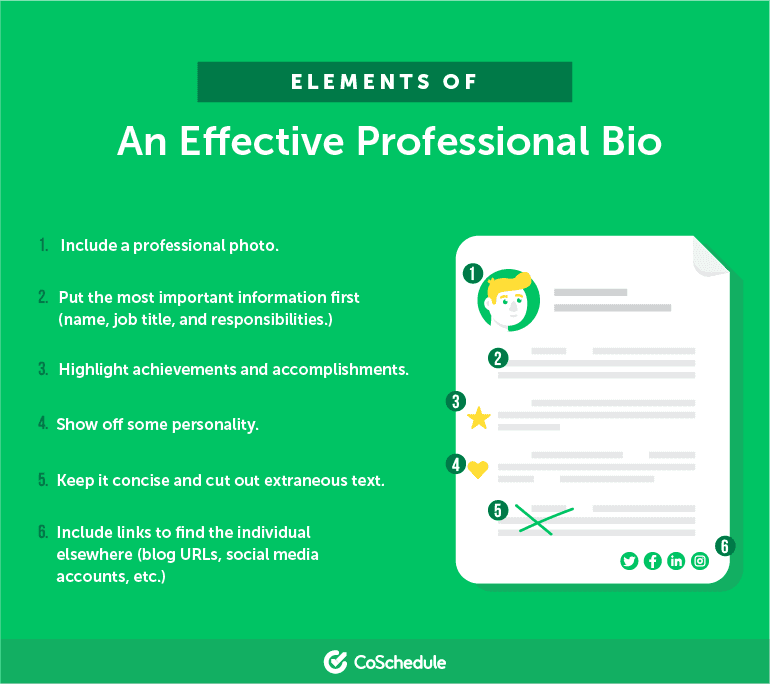 Try our new The #1 Free Instagram Bio Generator!
Also recommended: Professional Bio Generator
Try our new The #1 Free Instagram Bio Generator!
Also recommended: Professional Bio Generator
What Makes Them So Important?
People come across so many different pieces of information on the web that it’s tough to keep everything straight. It’s impossible to remember every interesting thing you come across, let alone filter through the overwhelming amount of junk you see that isn’t interesting at all. So, make your first impression something that sticks. If a social media user sees a stray post that catches their attention, they’ll want to see if it came from someone who looks and sounds trustworthy. The same goes for a blog post they might read, or a new company they’re scoping out for a potentially lucrative partnership. Whatever the case may be, a strong bio is an opportunity to leave a lasting impression. If it’s written well, people might be more influenced to consider you an authority, someone to remember to reach out to, or eventually, even make a purchase from.
When Would You Need to Write a Bio?
There are lots of different situations where you might need to provide a bio. Here are a few:- You work at a marketing or PR agency, and a client needs one to make an executive sound brilliant.
- It’s time to hunt for a new job, and your Twitter and LinkedIn profiles need some freshening up.
- The company’s website is getting a redesign, and each employee’s profile page needs a bio to go with it (and you get to/have to write it).
Where Might Your Bio Appear?
Plus, there are all kinds of places where it’s useful to have a crisp, clean, and creative description of yourself (or client or coworkers). Take a look at this list:- Your company’s website or blog.
- Guest blogs (if you write on another company or writer’s blog).
- Any personal websites, blogs, or portfolio pages you might have.
- On your social media accounts.
- Within press releases about your company (say, if an executive plays a key part in a major achievement).
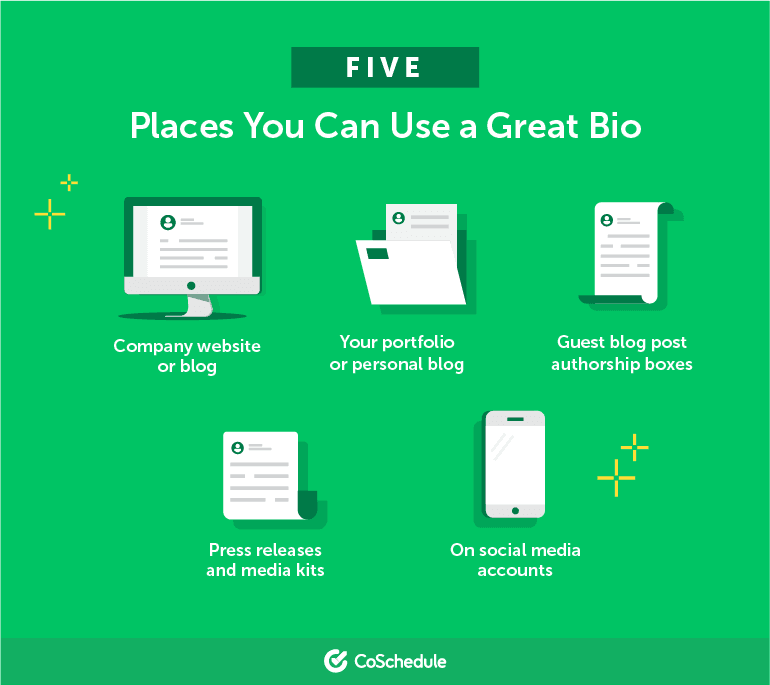 Certainly, you can probably think of even more, too. But, if you have one that’s well-written, it can easily be repurposed and repackaged to fit wherever it’s needed.
And that leads into the next point in this post.
Certainly, you can probably think of even more, too. But, if you have one that’s well-written, it can easily be repurposed and repackaged to fit wherever it’s needed.
And that leads into the next point in this post.
How Long Should a Bio Be?
There’s no one-size-fit-all answer here. Social media accounts often have obvious restrictions on character counts that limit length. If you’re writing one to appear in a press release boiler plate or a blog bio box, a paragraph is generally sufficient. But, if you’re writing one for a website page, you might be able to run as short, or as long, as you’d like. In fact, there are arguments to be made for keeping things concise or going more in-depth.Why Consider Writing a Short Professional Bio
People have short attention spans. According to the Nielsen Norman Group (via Crazy Egg), you have 59 seconds to hook a website viewer’s attention before they’ll leave. And they’re going to see a lot of things before they even get to your bio (headlines, homepage copy, and product pages are all possible places they’ll visit first). If hooking someone’s attention is hard, keeping it might be even more difficult, and arguably, no one wants to spend too much time getting to know you if they don’t have to. So, why not just get to the point? Take a look at this example from Influence and CO. founder John Hall: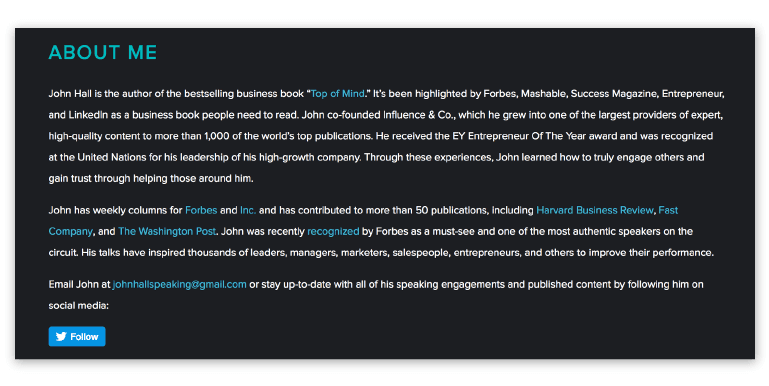 It’s just a couple concise paragraphs, plus a line for his email address. Note the smart inclusion of a Twitter follow button, too.
This works because:
It’s just a couple concise paragraphs, plus a line for his email address. Note the smart inclusion of a Twitter follow button, too.
This works because:
- It gets to the point.
- But, it doesn’t sacrifice substance for short length. It just excludes anything extraneous.
- The inclusion of links to other places to find him are smart.
Writing a professional bio? Here's why you might want to keep it short.
Click To TweetWhy Consider Writing a Long Professional Bio
But, what if you’re writing a description of a seasoned professional with tons of experience? How do you condense everything important to know about them into a short amount of space? That can be tough. And if people are likely to want to know all about the person’s story, it might make more sense to go long (spanning a few paragraphs, or even a whole page or more). Here’s another example from Darren Rowse, the founder of ProBlogger: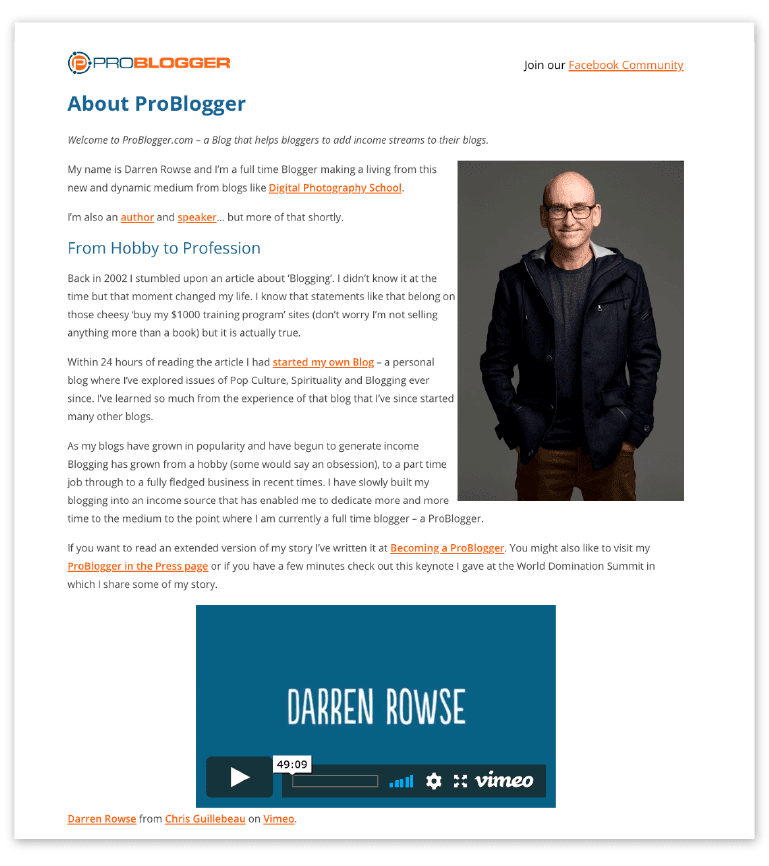 While this bio is still fairly compact, it spans multiple paragraphs, and even includes a video. Then, it extends a bit further to include more information about Darren and his business:
While this bio is still fairly compact, it spans multiple paragraphs, and even includes a video. Then, it extends a bit further to include more information about Darren and his business:
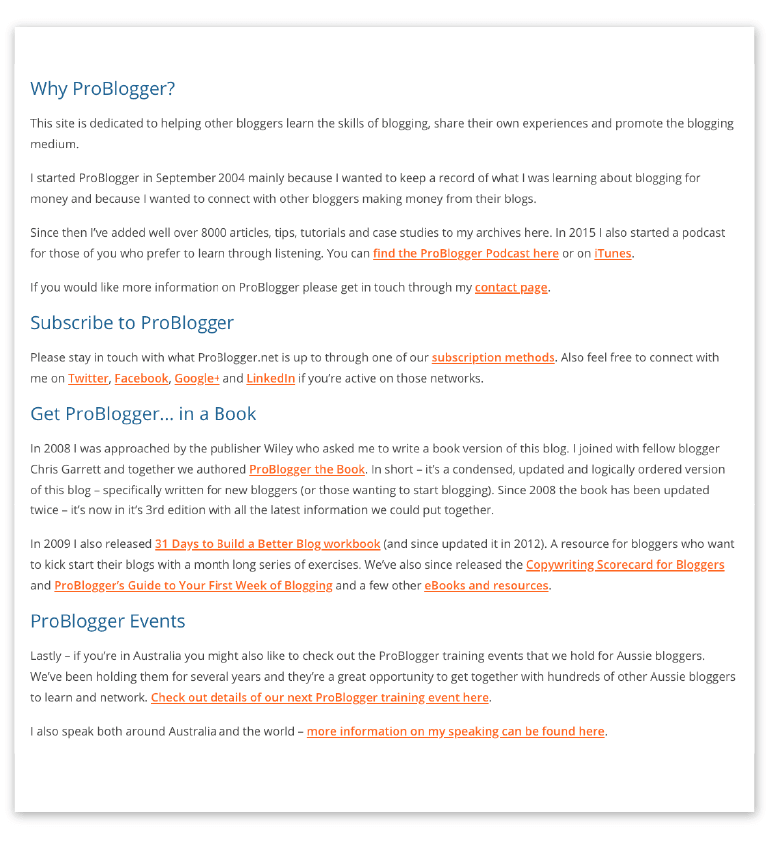 This works because:
This works because:
- It puts the most important information first.
- While it goes into detail, it’s still tightly written.
- All additional information included is relevant and useful.
Writing a professional bio? Here's why you might want to make yours detailed and in-depth.
Click To TweetSee What a Great Bio Looks Like With These 20 Real-Life Examples
If you’re looking for more sample biographies to follow, scope out this list. It includes executives from all different kinds of industries.- Stephanie Lundquist, Target
- Brian Mariotti, Funko
- Cesca Antonelli, Bloomberg
- Tracy Grant, The Washington Post
- Wendy Jones, eBay
- Joanna Wiebe
- Girl Develop It Leadership Team
- Wired (All Staff)
- Paula Kerger, PBS
- Mozilla Leadership Team
- HP Executive Team
- Rachel Glaser, Etsy
- Rob Manfred, Major League Baseball
- Tetsuo "Ted" Ogawa, Toyota
Basic Tips for Writing the Perfect Bio
For most types of bios, there are a handful of tips that’ll help keep your writing sounding crisp, clean, and convincing. Use CoSchedule's AI Bio Generator to write personalized bio's within seconds!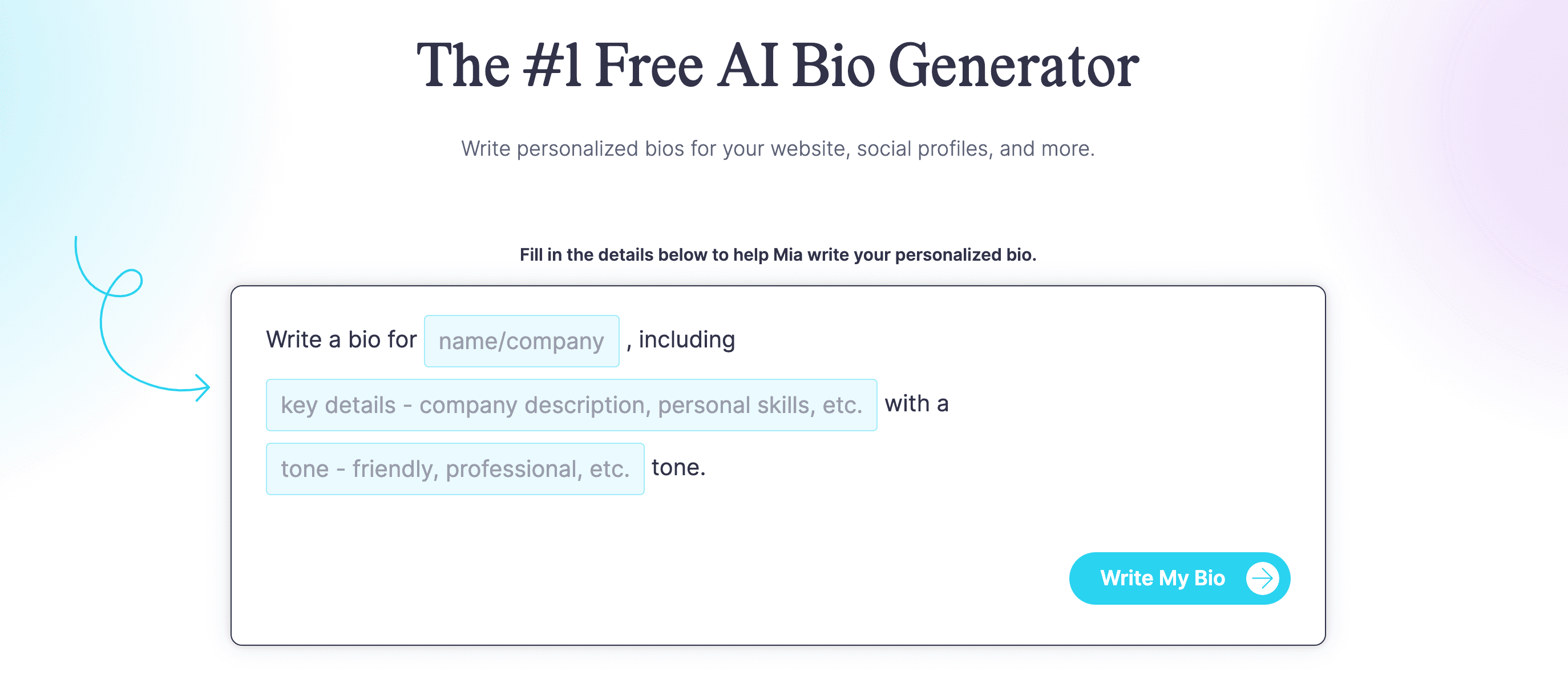 Source
Source
Write in the Third Person
If you’re writing about yourself, you might be able to make a stylistic decision between writing in first or third-person. Generally, though, third-person is the way to go (and really the only option if you’re writing one for someone else).Keep It Concise
Cut out any fluff or extraneous words. Even if you’re writing a longer bio that fills a full page or more, if it’s not essential or doesn’t add value, then cut it out.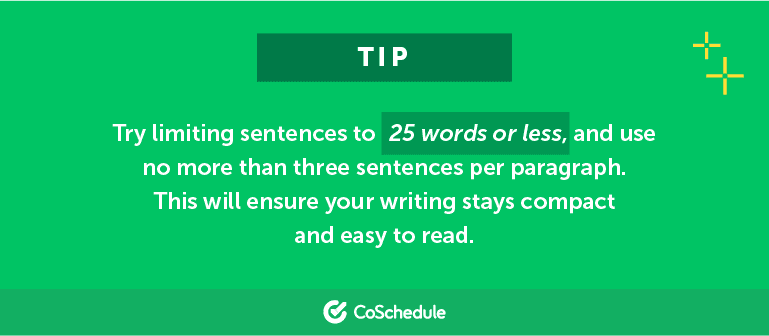
Stay Professional, But Give It Some Personality
This is a “professional bio,” and so it should sound, well, like you’re writing about a professional. But, what that entails might be different depending on the subject. If you’re writing for someone in a traditional business environment or industry, then sticking to a more formal style might be best. When writing a bio for someone in a creative or startup-type atmosphere, though, you might be able to loosen up your style a bit. The key takeaway is this: express the personality of the person you’re writing about in a way that’s appropriate for their industry. And you can use your best judgment here.Writing a Quality Bio for a Website in 8 Steps
Equipped with all of the previous background information, you’re now ready to start writing yourself. With some simple planning, you can streamline the entire project and get it knocked out quickly without sacrificing quality.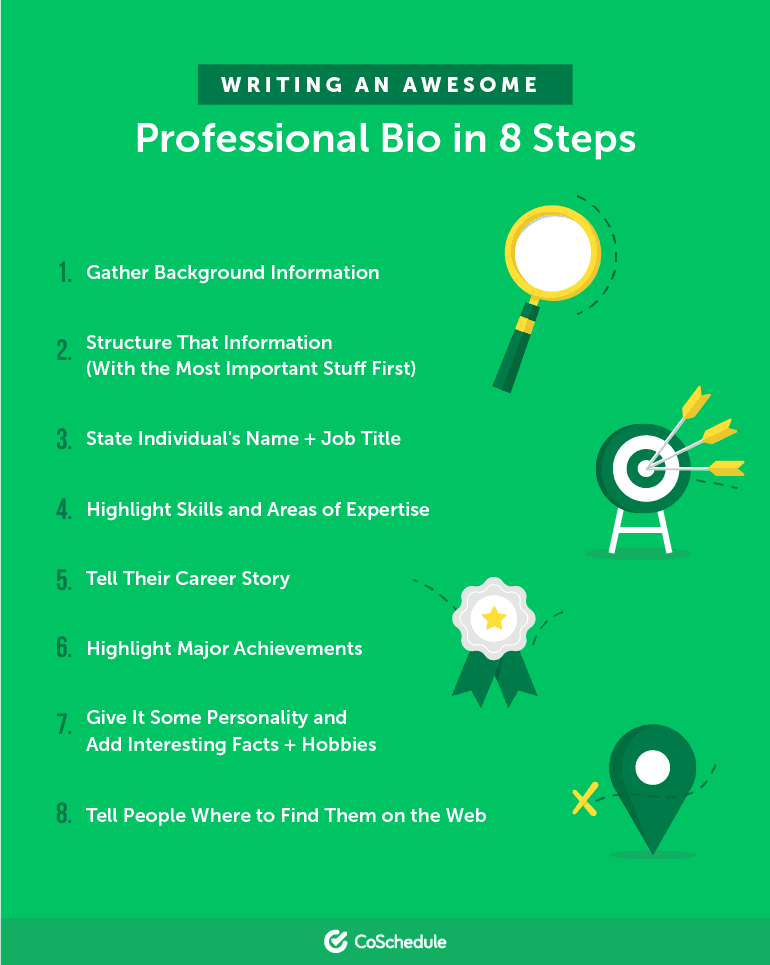
Step 1: Gather Background Information
If you’re writing one about yourself, this should (... hopefully) be easy. But, if you’re writing about someone else, you have a little bit of homework to do. Start by figuring out the person’s job title and what they actually do. This means developing a basic level of understanding about the person’s function with their company. You can do this in one of two ways:- Some simple Google searching.
- Set aside some time to speak with them one-on-one.
- What is your official, and complete, current job title?
- Can you list your professional experience starting with the beginning on your career?
- What are some of your top professional accomplishments?
- Have you been recognized with any awards you’d like to mention?
- Where can people find you on the web (social networks, personal site, etc.)?
Step 2: Structure That Information, With the Most Important Stuff First
Once you’ve done your research and rounded up all the background you’ll need, it’s time to start writing. Now, it’s important to prioritize the order you’ll write everything in. Here’s a fairly standard outline:- Name and job title.
- Description of their role and areas of expertise.
- Key achievements.
- Past work history.
- Previous achievements in prior roles.
- A little bit of personal information about their interests.
- Where to find the person elsewhere.
Step 3: Start By Stating Their Name + What They Do
Following your outline, start with their first name and their function. Here’s an example:Susan J. Marketer is the Chief Creative Officer at Awesome Company in Funky Town, Florida.No need to over-complicate this.
Step 4: Highlight Skills and Areas of Expertise
Next, explain what makes this person exceptional at what they do. Continuing on from the example established above:Her responsibilities include strategy, copywriting, and guiding Awesome Company’s business direction.That meets the purposes of this sentence, sure, but it’s pretty dry (especially for someone who works at, well, Awesome Company and lives in Funky Town … bear with us here). Here’s another example of the same idea:
She crafts creative concepts for companies small and large, turning boring brands into game-changing industry leaders that get people talking. How does she make this happen? With crisp copy that cuts through the noise, backed by sharp strategic thinking that differentiates exceptional clients from the also-rans.That’s a hypothetical example, but you get the idea: give it some life and go beyond repasting bullet points from resume.
Step 5: Walk Through The Subject’s Work History
Before your subject got where they are today, walk the reader through how they got there. This helps tell their story and show the path they took toward their current position. You don't necessarily need to tell your individual subject's entire life story. But, if you can, summarize relevant points while connecting their beginnings to where they're at now. For someone with a handful of recent positions, this should be easy. But, if someone has been in their career for a few decades, this could get to be quite a long list. Try following a format like this:Prior to joining [COMPANY], Susan developed her rockstar skills at [COMPANY] and [COMPANY], where she quickly established herself as the go-to expert on [TOPIC].Something like that.
Step 6: Mention Important Achievements
Anyone can claim they’re awesome. What’s more impressive than empty declarations about being great, though, are actual accolades and achievements that show someone knows their stuff. So, once you’ve established what your subject does, show how and why they’re good at what they do with some third-party affirmations. This could include mentioning:- Industry awards.
- Major career milestones.
- On-the-job accomplishments (with numbers and statistics).
- Speaking appearances.
Susan won Copywriter of the Year from the National Association of Awesome Copywriters in 2018. She also routinely appears on the speaking circuit, with recent appearances at [INSERT CONFERENCES HERE]. Her writing and expertise is also regularly featured on the CoSchedule Blog and other leading publications.That gets all the main points across in just three sentences. Can’t get much more concise than that. And no, the National Association of Awesome Copywriters isn’t an actual organization. :)
Step 7: Consider Adding Something About Personal Interests
This isn’t an essential item to include, but sharing something about personal interests can help humanize your subject, showing they’re an actual person and not just a list of skills and accomplishments. If they have hobbies or interests that correlate into their role, then so much the better. But, even something as simple as, “as a mother/father of three, they enjoy spending time with their family” is okay, too. Sometimes, small details like this can help authoritative figures comes across more personable and less intimidating than they might be.Step 8: List Links to Find Them Elsewhere
Does your subject have a social media presence? Does their writing regularly appear on any websites in particular? Consider adding:- Twitter, LinkedIn, or Instagram links.
- Links to blogs or websites.
- Event meetup links or other recurring gatherings they host (if any).
Copy and Paste This Professional Bio Template
Now, it’s time to pull everything together and actually write this thing. If you still could use some assistance, consider filling in this template (editing it as you see fit along the way):[NAME] is the [ROLE/JOB TITLE] at [COMPANY/ORGANIZATION], where [SHE/HE/THEY] work to [BENEFIT] [TARGET AUDIENCE] by [ROLE 1], [ROLE 2], and ROLE 3]. In [YEARS AT CURRENT COMPANY] with [CURRENT COMPANY/ORGANIZATION], [LAST NAME] has [PROFESSIONAL ACHIEVEMENT]. They have also [PROFESSIONAL ACHIEVEMENT], an achievement made possible by their [SKILLS/ATTRIBUTES]. Prior to joining [COMPANY/ORGANIZATION], [NAME] was responsible for [ROLE] at [COMPANY/ORGANIZATION]. While there, [SHE/HE/THEY] achieved [GOAL] by [SKILL/ACTION], driving [CHANGE/IMPACT] for [TARGET AUDIENCE]. [NAME] has appeared [AT CONFERENCE/EVENT, or IN LIST OF PUBLICATIONS]. [SHE/HE/THEY] have also [WON / BEEN RECOGNIZED WITH] the [AWARD], [AWARD], and [AWARD]. A graduate from [UNIVERSITY], [NAME] holds a degree in [AREA OF STUDY]. When not hard at work doing [JOB/ROLE], [SHE/HE/THEY] enjoys [HOBBY], [HOBBY], and [HOBBY]. Find [NAME] on [SOCIAL NETWORK/WEBSITE], [SOCIAL NETWORK/WEBSITE], and [SOCIAL NETWORK/WEBSITE].If you’d like to use this template in a pre-made Word doc, click here to move back up this post and download it. You’ll also get several additional variations of this template, too.


